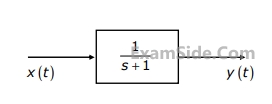1
GATE ECE 2006
MCQ (Single Correct Answer)
+1
-0.3
In the system shown below,
x(t) = (sint)u(t). In steady-state, the response y(t) will be
x(t) = (sint)u(t). In steady-state, the response y(t) will be

2
GATE ECE 2002
MCQ (Single Correct Answer)
+1
-0.3
A linear phase channel with phase delay $${\tau _p}$$ and group delay $${\tau _g}$$ must have
3
GATE ECE 1999
MCQ (Single Correct Answer)
+1
-0.3
The input to a channel is a band pass signal. It is obtained by linearly modulating a sinusoidal carrier with a signal- tone signal. The output of the channel due to this input is given by y(t) = (1/100) cos$$(100t - {10^{ - 6}})\,$$ cos$$({10^6}t - 1.56)$$. The group delay $$({t_g})$$ and the phase delay $$({t_p})$$, in seconds, of the channel are
4
GATE ECE 1996
MCQ (Single Correct Answer)
+1
-0.3
A rectangular pulse of duration T is applied to a filter matched to this input. The output of the filter is a
Questions Asked from Transmission of Signal Through Continuous Time LTI Systems (Marks 1)
Number in Brackets after Paper Indicates No. of Questions
GATE ECE Subjects
Signals and Systems
Representation of Continuous Time Signal Fourier Series Fourier Transform Continuous Time Signal Laplace Transform Discrete Time Signal Fourier Series Fourier Transform Discrete Fourier Transform and Fast Fourier Transform Discrete Time Signal Z Transform Continuous Time Linear Invariant System Discrete Time Linear Time Invariant Systems Transmission of Signal Through Continuous Time LTI Systems Sampling Transmission of Signal Through Discrete Time Lti Systems Miscellaneous
Network Theory
Control Systems
Digital Circuits
General Aptitude
Electronic Devices and VLSI
Analog Circuits
Engineering Mathematics
Microprocessors
Communications
Electromagnetics